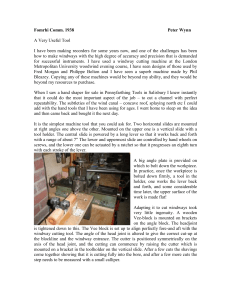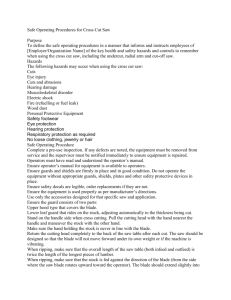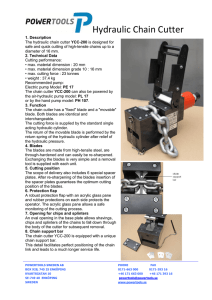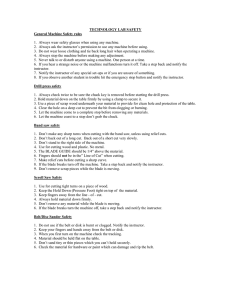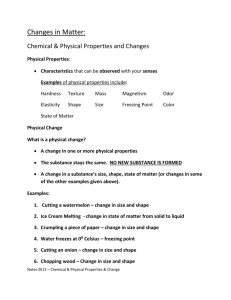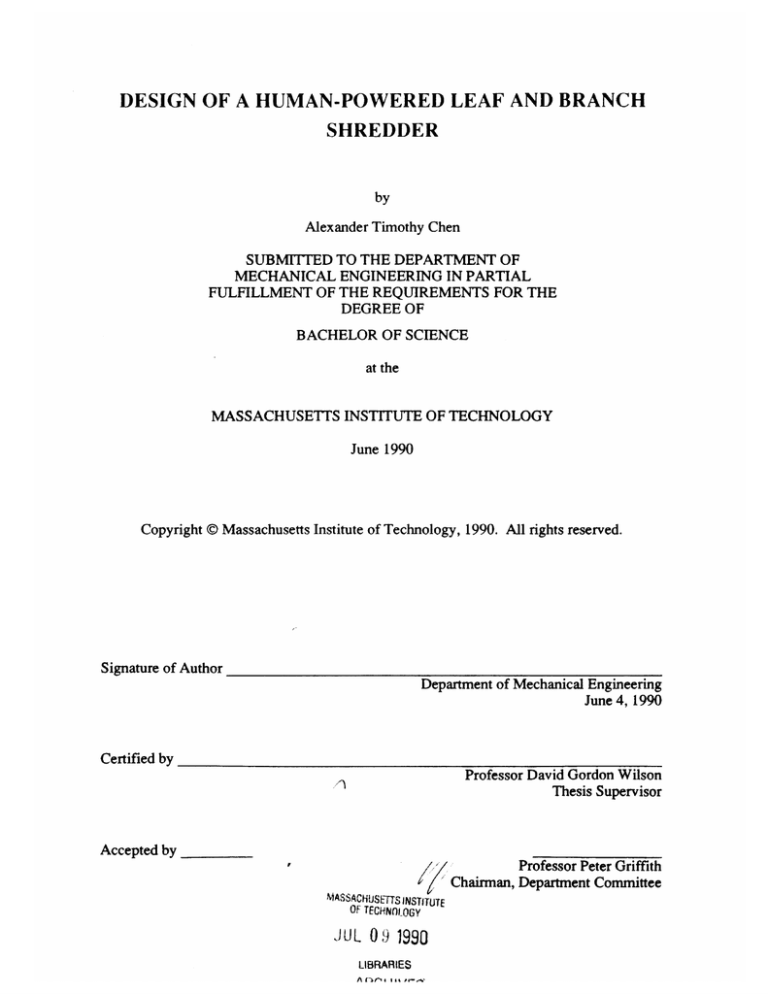
DESIGN OF A HUMAN-POWERED LEAF AND BRANCH
SHREDDER
by
Alexander Timothy Chen
SUBMFTED TO THE DEPARTMENT OF
MECHANICAL ENGINEERING IN PARTIAL
FULFILLMENT OF THE REQUIREMENTS FOR THE
DEGREE OF
BACHELOR OF SCIENCE
at the
MASSACHUSETTS INSTITUTE OF TECHNOLOGY
June 1990
Copyright @ Massachusetts Institute of Technology, 1990. All rights reserved.
Signature of Author
Department of Mechanical Engineering
June 4, 1990
Certified by
Professor David Gordon Wilson
Thesis Supervisor
I
Accepted by
Professor Peter Griffith
Chairman, Department Committee
MASSACHUSE-TTS INSTITUTE
OF TECHNOLOGy
JUL 09 1990
LIBRARIES
ARCHiIVEs
DESIGN OF A HUMAN-POWERED LEAF AND BRANCH
SHREDDER
by
Alexander Timothy Chen
Submitted to the Department of Mechanical Engineering on June 4, 1990 in
partial fulfillment of the requirements for the degree of Bachelor of Science.
Abstract
A human-powered device to "shred" leaves and branches would provide exercise for fit
people. Since this is a novel concept, experiments were conducted to determine the shear
strength of wood and the effect of the angle of cut on the cutting forces. The cutting
subassembly was designed, and a prototype blade spine was fabricated from a fiberglass
composite. No formal tests on the prototype were conducted.
Thesis Supervisor:
Title:
Professor David Gordon Wilson
Professor of Mechanical Engineering
-3-
Dedication
This thesis is significant in that it represents the end of my career at M.I.T. I would like to
first thank my parents, Arthur C. M. Chen ('61) and Carole Z. Chen, for their incessant,
though not always apparent, support. My sister, Holly S. Chen, also deserves thanks for her
encouragement, but mostly for her youthful wisdom and insight, which was perhaps more
useful to me at this stage of life than the advice of others. To Professor Woodie C. Flowers,
I owe my success in design; through 2.70, 2.73, and 2.944, he gave me the confidence to be
a good designer, and not to mention a great deal of advice. To William J. Moliski, a great
friend who had nothing to do with this thesis, I wish continued success during his remaining
year here. And last but certainly not least, to P. Jennings Daniel I give thanks for
encouragement, understanding, and companionship.
-4-
Table of Contents
Abstract
Dedication
Table of Contents
List of Figures
2
3
4
5
1. Introduction
6
2. Properties of Wood
2.1 Background and Prior Art
2.2 Shear Strength: Charpy Impact Test
2.2.1 Experimental
2.2.2 Results
2.3 The Dependence of Cutting Energy on Cutting Angle
2.3.1 Experimental
2.3.2 Results
7
7
8
8
8
13
13
13
3. Design and Prototype Fabrication
3.1 Background and Preliminary Design Concept
3.2 Cutter Subassembly
3.2.1 Design
3.2.2 Prototype Fabrication
3.2.3 Test and Evaluation
18
18
19
19
23
25
4. Conclusions and Recommendations
26
Appendix A. Raw Data from Charpy Impact Test
28
Appendix B. Raw Data from Cutting Angle Experiment
30
-5-
List of Figures
Figure
Figure
Figure
Figure
Figure
Figure
Figure
Figure
Figure
Figure
Figure
2-1:
2-2:
2-3:
2-4:
2-5:
2-6:
2-7:
2-8:
3-1:
3-2:
3-3:
Charpy impact test apparatus
Charpy V-Notch test specimen
Top view of a Charpy V-Notch test specimen
Charpy impact test of square oak specimens
Charpy apparatus adapted to measure cutting energy
End view of samples cut by the adapted Charpy test apparatus
Top view of adapted Charpy test samples cut at 900
Dependence of cutting energy on angle of cut
Schematic of the overall HPS design
Schematic of cutting assembly arrangement
Cutter design
2.2.1
2.2.2
2.2.2
2.2.2
2.3.1
2.3.2
2.3.2
2.3.2
3.1
3.2.1
3.2.1
-6-
Chapter 1
Introduction
The advent of Earth Day on April 22, 1990, is an indicator of the increasing public
awareness of environmental issues throughout the world. Recycling natural debris, such as
the leaves and branches collected during one's gardening activities, is as important as
recycling cans and bottles and plays a large role in the entire conservation theme. The
mechanical break-up of such material hastens the recycling process, and the invention of a
human-powered device to do this is a worthwhile pursuit. Such a device might also be a
good form of exercise.
In order to successfully design any machine tool, the material properties and dynamic
response of the intended workpieces must be known. For a cutting device such as a humanpowered leaf and branch shredder (HPS), the limiting property is the resistance of wood to
a cutting or shear force. The same resistance exhibited by leaves is not considered a critical
factor, although their behavior under a shear force will certainly affect the overall success
of the design. A patent search and library research proved unsuccessful in the quest for
such information, and so a variety of experiments were conducted with a modified Charpy
impact tester in order to find the shear strength of wood and the dependence of cutting
forces on the cutting angle.
Once the needed quantities and relationships were found, the design stage could
begin. A preliminary overall design was conceptualized, and the detailed design of the
actual cutter was completed and partially built.
The cutter spine, constructed from
fiberglass-reinforced composite, was not formally tested.
-7-
Chapter 2
Properties of Wood
2.1 Background and Prior Art
Since the advent of lightweight metals and more recently, advanced composites,
research conducted on the properties of wood has diminished to virtual non-existence. It
seems, however, that a significant amount of research was conducted in the 1950s, and
there are many books on the subject from that decade. Because of the inherent variations in
climate, soil, sunlight, and other factors, the properties of wood vary greatly, even within a
particular species. Material properties are thus listed according to species, with a given set
of conditions for growth, and are usually given in ranges.
Shear strength may be described as a measure of a material's ability to resist forces
that tend to cause one part of the material to slide or slip relative to another part adjacent to
it. Thus the shear strength of wood is directly related to its workability in terms of cutting.
The shear strength of wood was listed in a number of sources, but only for the case of a
force acting parallel to (along with) the grain. This is because the shear strength of wood
across the grain may be treated as infinite, since wood fails by tension, crushing across the
grain, or shear along the grain before it shears across the grain. [Wangaard 50] In an
informal experiment, a hollow-ground paper shear was used to crush some samples into two
pieces, thus confirming this notion. For samples of "clear" wood in both a green and an
air-dry condition, shear strength in the parallel direction ranged from a few hundred to
several thousand psi, and values for tensile strength in the direction perpendicular to the
grain were typically below one thousand psi. [Forest 55]
-8A search of patents granted after 1975 revealed no useful information, since most of
the devices which acted by shear were large devices used to cut entire trees, with virtually
no limits on power.
2.2 Shear Strength: Charpy Impact Test
2.2.1 Experimental
The configuration of the Charpy impact tester varies from model to model, but it
generally consists of a heavy, free-fall pendulum which strikes the sample at the angular
position with the lowest potential energy. Actual contact between the pendulum and the
sample is made with an angular striking head. Charpy energy is found by measuring the
angle of the follow-through swing, and thus a device to measure or convert the angle of
follow-through is included. The specimen rests on a mounting block which opposes the
forces of the striking pendulum and thus holds the sample in place. Figure 2-1 contains a
sketch of the Charpy apparatus used for this experiment.
Two types of samples were tested. All were roughly 55 x 10 x 10 mm, but half of the
samples had a 450 notch cut into the middle, which reduced the height of these samples by
about 2 mm. For each trial, the sample was placed in the mounting block, the pendulum
was raised and released, and the angle of the follow-through swing was recorded. The
measured angle was then converted into the energy required to break the sample.
2.2.2 Results
As predicted by background research, the primary mode of failure in the Charpy
impact test was tension, with some element of shear along the grain. Because of the fibrous
nature of wood, the v-notch had the effect only of reducing the sample's cross-sectional
area, and did little in terms of producing a stress concentration.
samples are presented in figures 2-2 and 2-3.
Photographs of some
-9-
2
5
6
7
Figure 2-1: Charpy impact test apparatus -- 1) impact head,
2) pendulum arm, 3) release lever, 4) angle gauge,
5) needle, 6) mounting block, 7) base and supports
The energy required to break the samples is found simply by calculating the
difference in potential energy between the maximum height of a free swing (in the absence
of a sample) trial and the maximum height of the follow-through swing during a regular
trial. This accounts for all forms of internal damping in the system. This may be expressed
initially as
CharpyEnergy = EFree Swing - EFollow-Through
(2.1)
-t0-
(a)
(b)
Figure 2-2: Charpy V-Notch test specimen. The mode of
failure is tension -- a) Top view, b) End view
-11-
Figure 2-3: Top view of a Charpy V-Notch test specimen. The sample
failed by both tension and shear parallel with the grain direction.
The energy in each of these two terms is the quantity mgl multiplied by the sine of some
angle. If $ is the angle of free swing minus 900, 0 is the follow-through angle less 900, m is
the mass of the pendulum, g is the gravitational constant, and I is the length from the axle to
the center of mass of the pendulum, then this formula reduces to
Charpy Energy = mgl [ sin()
- sin(O) ]
(2.2)
The results are presented in figure 2-4 on the following page. Values ranged from 46 to 89
ft-lbs, and are shown as a function of cross-sectional area.
This unusual behavior of wood under a shearing force across the grain was
discovered as a result of these experiments. At this point I returned to my references, only
-12-
100
t
00
0
75t
00
*0
0
Energy
_o.
(ft-lbf)
25t
50
100
75
125
150
Cross-sectional Area (mm2 )
Figure 2-4: Charpy impact test of square oak specimens. Unshaded
circles represent notched specimens, shaded unnotched.
to discover that the same explanation was the reason why no transverse shearing data were
presented. Not having obtained any useful data, a new set of experiments was designed and
are described in the next section.
13-
2.3 The Dependence of Cutting Energy on Cutting Angle
2.3.1 Experimental
These experiments were carried out with the same Charpy apparatus as used before,
but with a special adapter designed to hold a blade, shown in figure 2-5. This adapter,
made from aluminum, allows a blade to be positioned at a variety of angles, with minimal
changes in mass, center of mass, and initial striking position. For simplicity, only three
cutting angles -- 200, 450, and 900 as measured from the ground -- were tested, since we
wished to observe only a general trend and to obtain approximate values to guide the cutter
design. Round samples of 3/8" and 1/2" diameter were used.
2.3.2 Results
The energy required to cut the specimens is found using the same formula as the
Charpy impact test, equation (2.2), with an adjusted value of the mass m.
With this
exception, the changes in the system parameters are considered negligible. Photographs of
some cut samples are shown in figures 2-6 and 2-7.
The results are depicted graphically in figure 2-8 as the cutting energy per unit area
(ft-lbf/in 2 ) versus the blade angle, and values range from 440 to 1220 ft-lbf/in 2 . Contrary to
the anticipated trend, the minimum cutting energy comes from a blade angle of 900 -perpendicular to the cutting motion! This, however, may be the result of the design of the
experiment: a large component of the reaction force acts along the length of the pendulum
rod and terminates at the pendulum axle. This force component, which increases as the
cutting angle decreases, was large enough to cause vibrations and significant deflections in
the pendulum rod, and would be an interesting topic for future research. Of additional
curiosity, no sample was cut completely through, irregardless of the angle of cut. Rather,
each sample was cut until the remaining uncut portion of the sample was unable to
withstand the bending load exerted by the blade and failed by tension or one of the other
-14-
4
4D
2
1
4D
4D
B.S. THESIS
CHARPY
HEAD & ADAPTER
20APR.199
A.T. CHEN
Figure 2-5: Charpy apparatus adapted to measure cutting energy -- 1) blade,
2) blade mounting screws, 3) adapter block, 4) Charpy impact head,
5) pendulum arm, 6) mounting bolt for adapter block
modes. This may not be a factor for a slower cutting action of clamped, cantilevered
branches.
-15-
(a)
(b)
Figure 2-6: End view of samples cut by the adapted Charpy
test apparatus -- a) cut angle=25 0 , b) cut angle=45 0
-16-
(a)
(b)
Figure 2-7: Top view of adapted Charpy test samples cut at 900 -a) tensile failure mode, b) tensile failure with shear component.
-17-
a
1400
*
__
1050t
+
U
*
U
I.
0?
00
00
Energy/Area
(ft-lbf/sq in)
8
.
700t
0
08
350-
0
25
50
75
Cutting Angle (deg)
Figure 2-8: Dependence of cutting energy on angle of cut.
Shaded symbols represent 1/2" samples, unshaded 3/8".
100
-18-
Chapter 3
Design and Prototype Fabrication
3.1 Background and Preliminary Design Concept
The concept of a device to shred leaves and branches is old, but as previously
mentioned, the concept of a human-powered version of this device is new. A large number
of gas- or electric-powered shredders are available today, in a variety of sizes. All of these
employ a set of blades or pulverizers rotating at high speeds. Those in the lower power
ranges typically have many problems, particularly with clogging. Besides the issue of feedrate versus power, we are limited in our human-powered device by the power output of a
human, which is typically much less than even the smaller commercial shredders require.
Since the properties of wood dictate the minimum cutting force required, we must reduce
the power requirements by reducing the blade velocity.
Thus a well-designed human-
powered shredder will not be so much a shredder as a cutter.
Maximum human output can be achieved by many configurations, but a pedalpowered device is the simplest to obtain parts for, and this method has the further advantage
that a transmission (derailleur) is already built-in and is relatively easy to install. This
approach will necessarily involve some sort of incremental timing mechanism, since the
pedalling motion is inherently continuous while our cutter is not. Furthermore, the powerstroke should remain constant, and so the gearing or actuator should also be designed to
match any changing forces or moments inherent in the cutter design. For obvious safety
reasons, an overload cam or similar mechanism should be incorporated into the cutter or
drive mechanism.
-19-
The material feeder must also be incremental, but synchronized 1800 out-of-phase
with the cutter. By combining the feeder with the clamping mechanism, we reduce the
number of parts while at the same time making the design more energy-efficient:
if the
branches are never unclamped, then no energy is lost in an unclamp-advance-clamp cycle,
which allows the branches to store and release potential energy in a spring-like fashion. To
facilitate a two-stage advance/clamp-cut cycle, this portion of the HPS might incorporate a
medium-sized roller mounted opposite the anvil and material slide (or passive conveyorstyle belt). The roller mounting should be spring-loaded in order to accommodate varying
load geometries, but with a maximum clearance of about 1/2".
Branches and leaves are actually cut by the device explained in the next section. The
overall design is presented schematically in figure 3-1.
3.2 Cutter Subassembly
3.2.1 Design
The cutting motion with the smallest required cutting force will cut only one branch
at a time. To reduce losses incurred by compressing cantilevered branches, the branches
should be clamped directly against an anvil which opposes the force of the cutting motion.
Unfortunately, a simple geometry which satisfies both of these conditions, while utilizing
the ideal 900 cutting angle found in chapter one, does not exist. Minimization of the
required cutting force is the most important specification, and thus if the branches are to be
lined up along the length of an anvil, the blade must have a slight angle as it contacts the
branches, much like a guillotine. The cutter design with the smallest frictional losses is a
pivoting blade, since there is friction only in one pivot and at the blade/branch and
blade/anvil interfaces.
Other designs generally incorporate additional pivots or sliders
which increase frictional losses. The optimal design then, is similar to a paper shear, but
-20-
B.S. THESIS
OVERALL DESIGN CONCEPT
25APRL)990
A.T.
CHEN
Figure 3-1: Schematic of the overall HPS design -- 1) cutter
spine, 2) drive/pinch roller, 3) anvil, 4) gearset/derailleur,
5) main gear, 6) crank/pedal 7) feed slide, 8) seat/back rest
with a number of differences. The blade is offset from the pivot point to reduce the height
which the blade must lift in order to accomodate a branch near the pivot.
This
configuration also allows the blade to pass through a slot with closed ends. Also, the curve
of the blade is designed to maintain a constant cutting angle, and is shaped concave
downwards so the cutting forces tend to push the branches toward the center of rotation,
where the cutter affords the greatest mechanical advantage. A paper shear is curved in the
opposite way. Figure 3-2 shows a schematic of the cutting assembly arrangement.
Having arrived at a general shape for the cutting member, more specific details are
-21-
49
3
7
2
B.S. ThESIS
HIAN-POWEED SHREDDER
10 APRL 1990
AT. CHEN
Figure 3-2: Schematic of cutting assembly arrangement -1) spine, 2) pivot base, 3) pivot shaft, 4) blade, 7) anvil,
8) feed table, 9) cutter return/contact spring
necessary. The spine backing the blade must be very stiff in order to withstand the bending
moments involved. The worst case exists when the device is unable to cut a branch near the
pivot point, and the spine then acts as a cantilever beam. The deflection of a cantilever
beam is given by
F-3
3EI
(3.1)
where F is the force applied at the end of the beam, I is the beam's length, E is the elastic
modulus, and I is the moment of inertia. For a rectangular beam, the moment of inertia is
-22-
I W= ,
(3.2)
12
where b is the base width of the beam and h is the height. Combining equations (3.1) and
(3.2), we arrive at a relationship for the deflection of a rectangular cantilever beam
4F13
Ebh3
(3.3)
Thus, in order to maximize stiffness, we desire a beam that is very tall and thin. If we
initially assign values for the height and width of the beam as 1-1/2" and 3/8", respectively,
we find the deflection when cutting two branches (1/2" each) to be approximately 1/8" for a
steel spine, which is not unreasonable. To achieve the same stiffness with an aluminum
spine, the thickness and/or height become restrictive. In the actual design, the free end of
the spine need not have the maximum height, since the bending moments are significantly
lower.
It is unlikely that the forces acting on the cross-section of the beam will be uniform.
In the worst case, the blade pushes up on the spine from one bottom comer and the actuator
pulls down on the diagonally opposite top comer, thus producing a twisting moment.
Under these conditions, torsional shear stress becomes a concern. If Mt is the twisting
moment, then torsional shear stress t is given by
=.375
8Mt
hb 2
o.6 b
1+ 0
h
.
(3.4)
For our geometry and loading, the maximum shear stress was found to be 4232 psi, which
is well within the performance limits for most structural materials.
-23-
One final concern is the degree of torsional deflection given by the same twisting
moment Mt. If the beam is modeled as a torsional spring, then the degree of twist, a, is
given by the twisting moment divided by the torsional spring constant, Ka, or
Mt
a = --.
(3.5)
The torsional spring constant is given by the relationship
Ka = 5.3
S161
Ghib 3
3
b
1-0.63 ( 1
h
/
-
b
_b_
120e
(3.6)
which combined with equation (3.5) gives us a torsional deflection of 0.670, which is quite
small.
Given these parameters for the spine geometry, the cutter was designed with the
shape seen in figure 3-3. The blade spans an arc of 10", leaving an 8" cut across the anvil.
3.2.2 Prototype Fabrication
Although the original design calculations were based on the material properties of
steel, parts made from advanced composite materials are often simpler to fabricate, and still
afford great stiffness properties. Additionally, composites are light-weight and offer the
additional advantage of manufacturing flexibility. And so, with the intention of using a
plaster cavity mold for a carbon-fiber-reinforced composite, a wooden male mold of the
spine was initially constructed.
Fiberglass, however, is more resistant to stress
concentrations than graphite fibers, and since the support spine of a wood shredder is likely
to be subjected to nicks and cuts, fiberglass composite is more likely to produce a robust
part.
Because of this fact and the additional problems of time, cost, and equipment
limitations, the reinforcing material was changed from carbon-fiber to fiberglass.
Actual fabrication proceeded by cutting a 16 ft2 omnidirectional fiberglass mat into
-24-
1
2
3
B.S.
THESIS
HUMAN -POWEE
D AR& SO
SHEXXR
A T. CHEN
Figure 3-3: Cutter design -- 1) Spine, 2) Pivot Base, 3) Pivot
Shaft, 4) Blade, 5) Branch, 6) Roller, 7) Anvil
24 pieces with approximately the same profile as the spine. A clean, smooth working
surface was prepared and covered with a plastic wrap. The initial layer of fiberglass was
placed directly on the plastic wrap and coated with a mixture of 32 fl. oz. of polyester resin
and 11 cc of methyl ethyl ketone (MEK) peroxide. The resin was sequentially applied to
each piece of the fiberglass mat, and extra layers were added in a region at the curved end
for mounting the spine to a shaft. The final layered form was covered with another sheet of
plastic wrap and left to cure under pressure at 65 F for 24 hours. Pressure was achieved by
stacking solid weights on top of a piece of foam rubber. Once hardened, the edges were cut
-25-
and sanded to the correct shape, and holes were drilled for mounting a blade and a 1/2"
shaft.
3.2.3 Test and Evaluation
Although no formal tests were conducted, the finished part was well-designed and
-constructed. The spine stiffness was tremendous torsionally, as well as in both the vertical
and horizontal directions. This fact was verified with a simple bending test, conducted at
the hands of my very large friend Roland. Unfortunately, the laying surface was slightly
warped and thus the spine curvature through the thickness is oriented opposite to the
original design.
Additional defects include some surface imperfections produced by
bubbles which formed during the curing process. Otherwise, the part is quite satisfactory.
-26-
Chapter 4
Conclusions and Recommendations
The different experiments carried out on wood revealed some interesting facts. The
resistance of wood to a shear force transverse to the grain direction is dictated by its tensile
properties and its shear strength along the grain.
Wood is cut the "cleanest" at
approximately a 450 angle, but the least amount of energy -- and hence the smallest force --
is required at a 900 angle, i.e. straight on. Wood also tends to break before being cut
completely through. Part of the cutter design is now completed and built. There is little
else to be said about the HPS at this stage, except that there is a tremendous amount of
work left to be done. Suggestions for further work are perhaps best summarized as follows:
Shear Strength of Wood: Charpy Test
" Tensile tests conducted by pulling parallel to the grain would provide useful
information about the strength of wood when sheared across the grain, since
this was the predominant mode of failure in the Charpy tests. Charpy tests
oriented parallel with the grain might reveal interesting data as well. For dry
wood, most of these figures are currently available.
" Tests on "green" and knotty wood might prove useful, since the dynamic
properties of these kinds of samples are likely to be quite different from clear,
dry ones.
Dependence of Cutting Force on Cutting Angle
" The vertical component of the reaction force was quite large in the modified
Charpy test, and perhaps a better test without this relationship should be
devised. A better test would also eliminate "pinching," and thus frictional
energy, between the blade and the sample halves.
" Tests on "green" and knotty wood again might prove useful. "Green" wood
might help to find the lower limits of the required cutting force, and knotty
-27-
samples might help to find the upper limits. "Green" wood might also provide
a better understanding the effect of bending on the cutting action.
* Tests using toothed blades or rotary saws might reveal useful information
about these cutting actions which could be applied to the HPS design.
Design of Cutter Subassembly
* An extremely smooth surface with a concave-downward profile would be best
for laying up the cutter spine.
* A blade of ordinary steel is probably sufficient for early stages of prototyping
and testing.
* A roller/clamp subassembly would be the logical pursuit of the next HPS
designer.
-28-
Appendix A
Raw Data from Charpy Impact Test
Notched Samples
Area (mm x mm)
Angle (deg)
Energy (ft-lbf)
1
89.56
109.5
63.79
2
94.71
108.0
66.68
3
90.26
119.0
46.18
4
90.89
110.0
62.83
5
96.81
103.5
75.49
6
90.20
116.0
51.60
7
95.23
100.5
81.46
8
99.10
105.5
71.55
9
100.04
106.0
70.57
10
97.20
98.0
86.48
11
88.35
115.0
53.43
12
101.03
98.5
85.48
-29Unnotched Samples
Area (mm x mm)
Angle (deg)
Energy (ft-lhf)
1
111.94
113.0
57.15
2
109.20
107.0
68.62
3
109.20
111.0
60.93
4
100.89
110.0
62.83
5
106.91
105.0
72.53
6
109.80
101.5
79.47
7
94.27
107.0
68.62
8
99.09
106.5
69.60
9
111.29
97.0
88.50
10
113.18
97.0
88.50
11
108.16
97.0
88.50
12
111.30
101.0
80.46
13
104.03
107.0
68.62
14
103.00
110.0
62.83
-30-
Appendix B
Raw Data from Cutting Angle Experiment
Thin Round Samples (3/8" dia.)
Cut Angle (deg)
1
90
Swing (deg)
Energy (ft-lbf)
E/A
118.5
53.90
488.04
2
121.0
48.85
442.25
3
114.0
63.30
573.17
4
115.0
61.18
553.97
5
114.0
63.30
573.17
6
110.0
71.95
651.40
7
116.0
59.08
534.93
8
116.0
59.08
534.93
9
116.5
58.04
525.47
10
120.0
50.85
460.43
112.0
67.59
612.01
12
108.0
76.35
691.29
13
116.0
59.08
534.93
14
114.0
63.30
573.17
15
115.0
61.18
553.97
16
115.0
61.18
553.97
17
116.0
59.08
534.93
18
99.0
96.72
875.74
19
116.0
59.08
534.93
11
45
-31-
Thin Round Samples (Continued)
Cut Angle (deg)
Swing (deg)
E/A
Energy (ft-lbf)
20 20
96.0
103.65
938.48
21
109.0
74.14
671.29
22
83.0
133.88
1212.16
23
101.0
92.13
834.18
24
94.0
108.30
980.52
25
103.0
87.58
792.91
26
100.0
94.42
854.93
27
90.0
117.61
1064.84
28
100.0
94.42
854.93
29
100.0
94.42
854.93
-32-
Thick Round Samples (1/2" dia.)
Cut Angle (deg)
1
90
Swing (deg)
Energy (ft-lbf)
E/A
70
163.27
831.53
2
94
108.30
551.54
3
80
140.79
717.05
4
84
131.56
670.05
5
93
110.62
563.39
6
76
149.91
763.47
7
80
140.79
717.05
8
89
129.94
610.84
9
95
105.97
539.71
10
73
156.64
797.77
11 45
55
194.19
988.98
12
54
196.08
998.64
13
60
184.36
938.95
14
45
212.01
1079.78
15
59
186.37
949.18
16
59
186.37
949.18
17
54
196.08
998.64
18
63
178.22
907.67
19
37
224.23
1142.01
20
63
178.22
907.67
45
212.01
1079.78
22
57
190.32
969.30
23
37
224.23
1142.01
24
59
186.37
949.18
25
53
197.96
1008.18
26
65
174.03
886.34
27
59
186.37
949.18
28
57
190.32
969.30
29
47
208.66
1062.70
30
68
167.62
853.69
21
25
-33-
References
[Calibration 54]
Calibrationof Charpy Impact Test, No. 208
Massachusetts Institute of Technology, 1954.
[Desch 73]
Desch, H. E.
Timber: Its Structure and Properties.
St. Martin's Press: New York, 1973.
[Forest 55]
Forest Products Laboratory, U.S. Forest Service.
Agriculture HandbookNo. 72: 'Wood Handbook'.
U.S. Dept. of Agriculture: Washington D. C., 1955.
[Wangaard 50]
Wangaard, F. F.
The MechanicalPropertiesof Wood.
John Wiley & Sons, Inc.: New York, 1950.
[Wee 89]
Wee, Kee Young.
Cutting Data for the Design of a Human-Powered Shredder.
June, 1989.
Bachelor's thesis.

